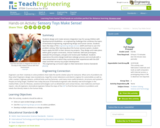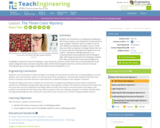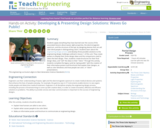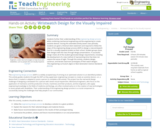
Describes the important structures of the human eye and how they work so that we can see images. [4:47]
- Subject:
- Science
- Material Type:
- Audio/Video
- Provider:
- Wisc-Online (Wisconsin Technical Colleges System)
- Date Added:
- 07/01/2022

Describes the important structures of the human eye and how they work so that we can see images. [4:47]

Students design and create sensory integration toys for young children with developmental disabilities an engineering challenge that combines the topics of biomedical engineering, engineering design and human senses. Students learn the steps of the engineering design process (EDP) and how to use it for problem solving. After learning about the human sensory system, student teams apply the EDP to their sensory toy projects. They design and make plans within given project constraints, choose materials, fabricate prototypes, evaluate the prototypes, and give and receive peer feedback. Students experience the entire design-build-test-redesign process and conclude with a class presentation in which they summarize their experiences with the EDP steps and their sensory toy project development.

Grades 8-12. Students are introduced to an engineering challenge in which they are given a job assignment to separate three types of apples. However, they are unable to see the color differences between the apples, and as a result, they must think as engineers to design devices that can be used to help them distinguish the apples from one another. Solving the challenge depends on an understanding of wave properties and the biology of sight. After being introduced to the challenge, students form ideas and brainstorm about what background knowledge is required to solve the challenge. A class discussion produces student ideas that can be grouped into broad subject categories: waves and wave properties, light and the electromagnetic spectrum, and the structure of the eye.

Students learn about the anatomical structure of the human eye and how humans see light, as well as some causes of color blindness. They conduct experiments as an example of research to gather information. During their investigations, they test other students' vision, gathering data and measurements about when objects appear blurry. These topics help students prepare to design solutions to an overarching engineering challenge question.

Students apply everything they have learned over the course of the associated lessons about waves, light properties, the electromagnetic spectrum, and the structure of the eye, by designing devices that can aid color blind people in distinguishing colors. Students learn about the engineering design process and develop three possible solutions to the engineering design challenge outlined in lesson 1 of this unit. They create posters to display their three design ideas and the comparisons used to select the best design. Then, students create brochures for their final design ideas, and "sell" the ideas to their "client." Through this activity, students complete the legacy cycle by "going public" with the creation of their informative posters and brochures that explain their designs, as well as color blindness and how people see color, in "client" presentations.

Students are presented with a challenge question concerning color blindness and asked to use engineering principles to design devices to help people who are color blind. Using the legacy cycle as a model, this unit is comprised of five lessons designed to teach wave properties, the electromagnetic spectrum, and the anatomy of the human eye in an interactive format that introduces engineering applications and real-world references. It culminates with an activity in which student teams apply what they have learned to design devices that can aid people with colorblindness in distinguishing colors— as evidenced by their creation of brainstorming posters, descriptive brochures and short team presentations, as if they were engineers reporting to clients. Through this unit, students become more aware of the connections between the biology of the eye and the physical science concept of light, and gain an understanding of how those scientific concepts relate to the field of engineering.

Students further their understanding of the engineering design process while combining mechanical engineering and bioengineering to create assistive devices. During this extended activity (seven class periods), students are given a fictional client statement and required to follow the steps of the engineering design process (EDP) to design a new wristwatch face for a visually impaired student at their school. Student groups share their designs with the class through design presentations. A successful design meets all of the student-generated design requirements, including the development of a new method of representing time that does not require the sense of sight. Through this activity, students design, construct and iterate classroom prototypes of their watch designs.